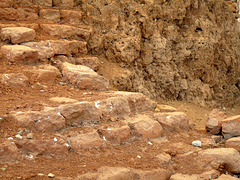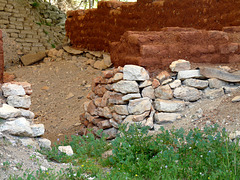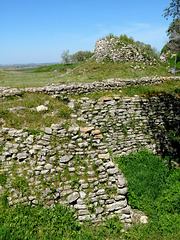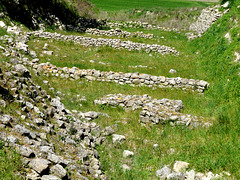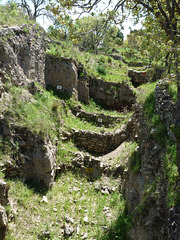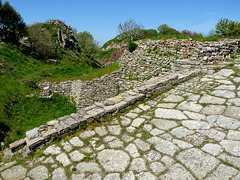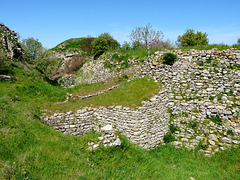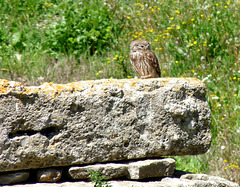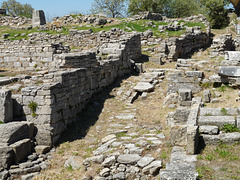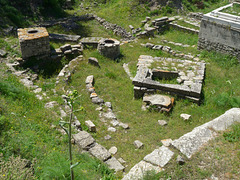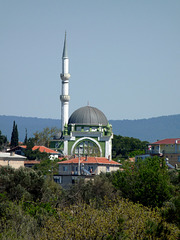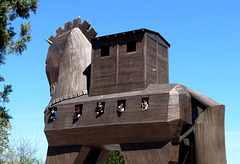
Turkey 2015
Troy- Citadel Wall
| |
|
Troy- The Megaron Building
| |
|
A Megaron is a large rectangular building usually entered on its shorter, south-facing end where there is a deep porch. The walls of wood and mud-brick are massive, built to take the weight of the roof because there are hardly any interior supports. In the inner chamber there is a large circular hearth. The smoke is let out through a hole in the roof. Inside these upper city megarons, archaeologists have found some objects of great value but little use, such as ornamental axe heads carved from single pieces of lapis lazuli, a semi-precious stone from far away in the east. Such objects seem to show that religious activities took place here.
Troy- Fortification Wall
| |
|
Troy- Houses in Schliemann's Trench
| |
|
In 1868, Heinrich Schliemann, a wealthy German businessman, began to excavate the site. He was determined to find the city which had been destroyed in the Trojan War, so he dug a great trench across the site, looking for a walled city that had been destroyed by fire. He scattered anything in his way, including part of a Greek temple. Unfortunately he dug right past the actual level he was looking for. Famously, he found, or claimed to have found 'Priam's Treasure', consisting of bronze axes, a plate cauldron and vase of bronze, gold vessels and gold jewellery. He found it in June 1873, claiming that his wife Sophia had helped him smuggle it off site in her shawl (she wasn't actually there at the time). He smuggled it out of Turkey, to Germany and presented it to the German Government and was displayed in a Berlin museum. It disappeared in WW2 and re-surfaced in Moscow in 1994. ( www.forumancientcoins.com )
Troy- Schliemann's Trench
| |
|
In 1868, Heinrich Schliemann, a wealthy German businessman, began to excavate the site. He was determined to find the city which had been destroyed in the Trojan War, so he dug a great trench across the site, looking for a walled city that had been destroyed by fire. He scattered anything in his way, including part of a Greek temple. Unfortunately he dug right past the actual level he was looking for. Famously, he found, or claimed to have found 'Priam's Treasure', consisting of bronze axes, a plate cauldron and vase of bronze, gold vessels and gold jewellery. He found it in June 1873, claiming that his wife Sophia had helped him smuggle it off site in her shawl (she wasn't actually there at the time). He smuggled it out of Turkey, to Germany and presented it to the German Government and was displayed in a Berlin museum. It disappeared in WW2 and re-surfaced in Moscow in 1994. ( www.forumancientcoins.com )
Troy- Schliemann's Trench
| |
|
In 1868, Heinrich Schliemann, a wealthy German businessman, began to excavate the site. He was determined to find the city which had been destroyed in the Trojan War, so he dug a great trench across the site, looking for a walled city that had been destroyed by fire. He scattered anything in his way, including part of a Greek temple. Unfortunately he dug right past the actual level he was looking for. Famously, he found, or claimed to have found 'Priam's Treasure', consisting of bronze axes, a plate cauldron and vase of bronze, gold vessels and gold jewellery. He found it in June 1873, claiming that his wife Sophia had helped him smuggle it off site in her shawl (she wasn't actually there at the time). He smuggled it out of Turkey, to Germany and presented it to the German Government and was displayed in a Berlin museum. It disappeared in WW2 and re-surfaced in Moscow in 1994. ( www.forumancientcoins.com )
Troy- The Ramp
| |
|
Part of the fortification wall contains the partially restored ramp of the Troy II citadel. ( www.virtualtourist.com )
Troy- Site Where Schliemann Found Treasure
| |
|
In 1868, Heinrich Schliemann, a wealthy German businessman, began to excavate the site. He was determined to find the city which had been destroyed in the Trojan War, so he dug a great trench across the site, looking for a walled city that had been destroyed by fire. He scattered anything in his way, including part of a Greek temple. Unfortunately he dug right past the actual level he was looking for. Famously, he found, or claimed to have found 'Priam's Treasure', consisting of bronze axes, a plate cauldron and vase of bronze, gold vessels and gold jewellery. He found it in June 1873, claiming that his wife Sophia had helped him smuggle it off site in her shawl (she wasn't actually there at the time). He smuggled it out of Turkey, to Germany and presented it to the German Government and was displayed in a Berlin museum. It disappeared in WW2 and re-surfaced in Moscow in 1994.
( www.forumancientcoins.com )
Troy- Little Owl at the Sanctuary
| |
|
Troy- Roman Odeon
| |
|
Troy- Roman Odeon
| |
|
Troy- The South Gate
| |
|
This is the South Gate of Troy VI that was probably the principal entrance to the citadel. Of the gate, only the roadway survives today. It led in a straight line up into the citadel and was entirely paved with stone slabs. In the middle of the road a drainage channel, possibly of Troy VII date, runs beneath the paving-stones.
( www.virtualtourist.com )
Troy- Drainage Channel at the South Gate
| |
|
Troy- Wall Above the Roman Odeon
| |
|
Troy- The Sanctuary
| |
|
The sanctuary was, perhaps, founded as early as the first quarter of the seventh century BC. It was dug into the ruins of the lower town of Troy VI and VII and these Archaic remains seem to have included altars, walled precincts and large buildings, perhaps temples. Best preserved is the altar in the so-called Lower Sanctuary. It is not known to which god or gods the Archaic Sanctuary was dedicated, but it remained in use throughout the Hellenistic period and long into Roman Imperial times. ( www.virtualtourist.com )
Troy- The Sanctuary
| |
|
The sanctuary was, perhaps, founded as early as the first quarter of the seventh century BC. It was dug into the ruins of the lower town of Troy VI and VII and these Archaic remains seem to have included altars, walled precincts and large buildings, perhaps temples. Best preserved is the altar in the so-called Lower Sanctuary. It is not known to which god or gods the Archaic Sanctuary was dedicated, but it remained in use throughout the Hellenistic period and long into Roman Imperial times. ( www.virtualtourist.com )
Troy- Gokcal Mosque
| |
|
Troy- Tourists Inside the 1975 Representation of t…
| |
|
Jump to top
RSS feed- Latest items - Subscribe to the latest items added to this album
- ipernity © 2007-2024
- Help & Contact
|
Club news
|
About ipernity
|
History |
ipernity Club & Prices |
Guide of good conduct
Donate | Group guidelines | Privacy policy | Terms of use | Statutes | In memoria -
Facebook
Twitter

